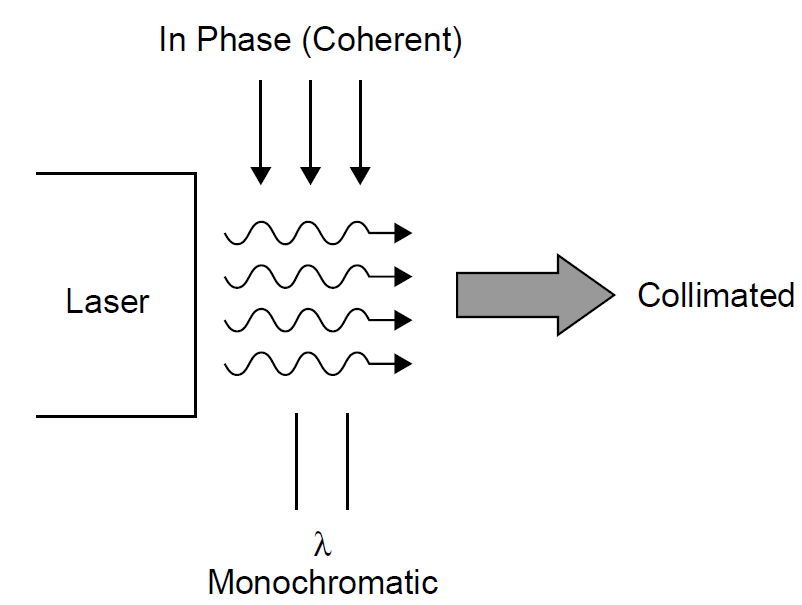
CHARACTERISTICS OF COHERENT LIGHT
 المؤلف:
Mark Csele
المؤلف:
Mark Csele
 المصدر:
FUNDAMENTALS OF LIGHT SOURCES AND LASERS
المصدر:
FUNDAMENTALS OF LIGHT SOURCES AND LASERS
 الجزء والصفحة:
p84
الجزء والصفحة:
p84
 10-3-2016
10-3-2016
 3431
3431
CHARACTERISTICS OF COHERENT LIGHT
In the first few chapters we have examined incoherent light, the light normally produced by gas discharges, blackbody sources, and the like. We’ve also examined the basic quantum mechanics behind these sources. Lasers, like any other light sources, are governed by the same rules and principles, but laser light is unlike any other source found in nature. It has three special properties that lead to its usefulness in many applications: coherence, monochromaticity, and collimation (directionality) as shown in Figure 1.1.
Coherence is the most interesting property of laser light. This property states that all photons emitted from a laser are at exactly the same phase; as waves they all “crest” and “valley” at the same time. Coherence is brought about by the mechanism of the laser itself (stimulated emission), in which photons are essentially

copied. To stay in phase it is required that all emitted photons are at exactly the same wavelength (or very, very close). If some photons are at a different wavelength, the phase of those photons relative to others will be different and the light will not be coherent. They must also be highly directional, all moving in the same direction. The property of coherence, then, gives rise to the other two properties of laser light.
Coherence is not trivial and is brought about by the amplification mechanism of the laser. Think of a beam of incoherent light as having a large number of photons, all acting as waves, with random phases relative to each other. As with any other wave, constructive and destructive interference will occur. The beam is a jumble of all sorts of photons at various wavelengths and phases. In a laser beam all photons travel in lockstep with each other, cresting at the same time. The photons complement each other, rendering high amplitudes (high intensities in our case). Indeed, although a 1-mW laser beam does not sound like much power, consider that this intensity is packed into a spot 1 mm in diameter. As a density this represents 1.2 kW/m2, a level surpassing the intensity of the sun on the surface of the Earth!
Monochromaticity is the ability of the laser to produce light that is at one well defined wavelength. It is a requirement for coherence since photons of varying wavelengths cannot be coherent (i.e., in phase). When white light is dispersed through a prism, you note that it is composed of an infinite number of wavelengths of light covering the entire visible spectrum as well as into the UV and IR regions. Now consider an emission line from a gas discharge. These lines are much narrower when viewed on a spectroscope. The range of wavelengths spanned by such a line depends on many factors, such as gas pressure, but suffice it to say that it is finite and could well be 0.1 nm in width. As we shall see in this chapter, the light produced by most lasers is much narrower, spectrally. A standard He Ne laser will produce a red light centered at 632.8 nm with a linewidth of only 0.002 nm! That is much narrower than any incoherent source can produce. Some lasers can produce multiple output lines; the argon-ion laser produces up to 10 lines in the blue–green region of the visible spectrum. Each of those lines is also (spectrally) very, very narrow. The argon laser has many allowable lasing transitions. (Quantum mechanics shows that argon has intricate and complex energy-level structures.) Each of those transitions lases, and many can lase simultaneously, but each produces a spectrally narrow output.
Collimation is the property of laser light that allows it to stay as a tight, confined beam for large distances. It can be thought of as the spread in a beam of light (called divergence). This property of laser light makes it possible to use the laser as a level in construction or to pinpoint speeders on a highway. The simplest explanation for the highly directional output of the laser is in the mechanism of the laser itself. In our example of the He Ne laser, photons of light inside the tube must be reflected by the mirrors many times (hundreds of times) before exiting through the front of the laser tube. To do this, photons must be very well aligned to the axis of the tube: Photons emitted at even a slight angle to the tube axis will be bounced into the walls of the tube and will not contribute to the output beam. All laser beams have some amount of divergence. Some lasers with very high gains such as nitrogen lasers have wider divergences, whereas others, such as the He Ne laser, have low divergences. The divergence of a laser beam can never be made zero, though, since diffraction limiting (from the laser aperture) is always an overriding principle.
 الاكثر قراءة في مواضيع عامة في الليزر
الاكثر قراءة في مواضيع عامة في الليزر
 اخر الاخبار
اخر الاخبار
اخبار العتبة العباسية المقدسة


